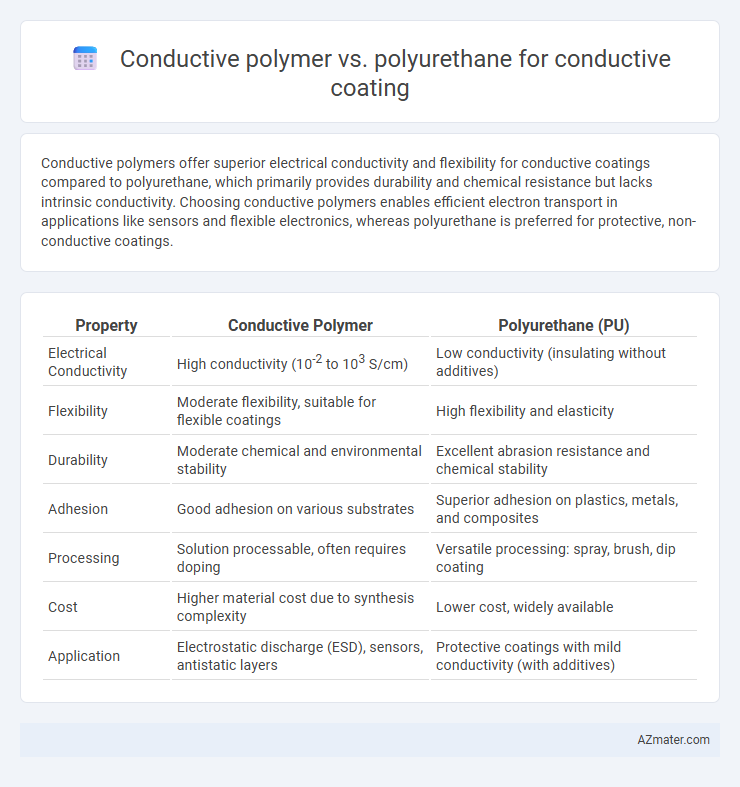Conductive polymers offer superior electrical conductivity and flexibility for conductive coatings compared to polyurethane, which primarily provides durability and chemical resistance but lacks intrinsic conductivity. Choosing conductive polymers enables efficient electron transport in applications like sensors and flexible electronics, whereas polyurethane is preferred for protective, non-conductive coatings.
Table of Comparison
| Property | Conductive Polymer | Polyurethane (PU) |
|---|---|---|
| Electrical Conductivity | High conductivity (10-2 to 103 S/cm) | Low conductivity (insulating without additives) |
| Flexibility | Moderate flexibility, suitable for flexible coatings | High flexibility and elasticity |
| Durability | Moderate chemical and environmental stability | Excellent abrasion resistance and chemical stability |
| Adhesion | Good adhesion on various substrates | Superior adhesion on plastics, metals, and composites |
| Processing | Solution processable, often requires doping | Versatile processing: spray, brush, dip coating |
| Cost | Higher material cost due to synthesis complexity | Lower cost, widely available |
| Application | Electrostatic discharge (ESD), sensors, antistatic layers | Protective coatings with mild conductivity (with additives) |
Introduction to Conductive Coatings
Conductive polymers, such as polyaniline and polypyrrole, offer excellent electrical conductivity and flexibility, making them ideal for advanced conductive coatings. Polyurethane-based conductive coatings provide superior mechanical durability and chemical resistance, suitable for harsh environmental applications. Choosing between conductive polymer and polyurethane coatings depends on specific requirements like conductivity level, flexibility, and environmental resilience.
Overview of Conductive Polymers
Conductive polymers, such as polyaniline and polypyrrole, exhibit intrinsic electrical conductivity due to their conjugated molecular structure, making them ideal for use in conductive coatings. These polymers offer advantages including flexibility, lightweight properties, and tunable conductivity through doping processes, enabling diverse applications in sensors, antistatic layers, and electromagnetic interference shielding. Unlike polyurethane, which is primarily an insulating polymer requiring added conductive fillers, conductive polymers provide a homogeneous conductive matrix without compromising mechanical elasticity.
What is Polyurethane?
Polyurethane is a versatile polymer widely used as a conductive coating due to its excellent chemical resistance, flexibility, and durability. Unlike conductive polymers that inherently carry electrical charge, polyurethane serves as a binder or matrix, often combined with conductive additives like carbon black or metal particles to achieve conductivity. This composite approach enhances mechanical properties and environmental stability, making polyurethane-based conductive coatings suitable for wearable electronics, sensors, and corrosion protection applications.
Electrical Conductivity: Conductive Polymers vs Polyurethane
Conductive polymers exhibit significantly higher electrical conductivity than polyurethane due to their conjugated molecular structures that facilitate electron mobility. Polyurethane coatings are inherently insulating but can be made conductive only by incorporating conductive fillers, which often results in lower and less stable conductivity. The superior electrical performance of conductive polymers makes them ideal for applications requiring efficient charge transport and responsiveness in conductive coatings.
Mechanical Properties Comparison
Conductive polymers generally exhibit lower tensile strength and elasticity compared to polyurethane, but they offer superior electrical conductivity essential for conductive coatings. Polyurethane provides excellent mechanical durability, flexibility, and abrasion resistance, making it ideal for protective layers in flexible electronic applications. The mechanical robustness of polyurethane enhances coating longevity, while conductive polymers ensure effective charge transport, highlighting a trade-off between electrical performance and mechanical strength in conductive coatings.
Durability and Environmental Resistance
Conductive polymers typically offer superior electrical performance but may exhibit lower durability and environmental resistance compared to polyurethane-based conductive coatings. Polyurethane coatings provide enhanced mechanical strength, abrasion resistance, and excellent protection against moisture, UV radiation, and chemical exposure, extending the lifespan of conductive surfaces. Choosing between the two depends on application requirements, with polyurethane favored in harsh environments and conductive polymers preferred for high conductivity needs.
Application Areas and Performance
Conductive polymers offer superior electrical conductivity and flexibility, making them ideal for applications in flexible electronics, antistatic coatings, and sensors, whereas polyurethane-based conductive coatings excel in durability, abrasion resistance, and chemical stability, suited for industrial machinery and protective surfaces. The performance of conductive polymers is optimized in low-temperature environments and wearable electronics due to their lightweight and stretchability, while polyurethane coatings maintain conductivity under harsh mechanical stress and exposure to solvents. Selection between these materials depends on the operational environment, with conductive polymers favored for precision electronic components and polyurethane preferred for robust, long-lasting conductive layers in heavy-duty applications.
Processing and Application Methods
Conductive polymers offer facile solution-based processing methods such as spin coating and inkjet printing, enabling precise patterning for electronic applications. Polyurethane-based conductive coatings provide robust mechanical flexibility and strong adhesion, typically applied through spray coating or dip coating techniques for large-area substrates. Processing conductive polymers requires controlled environmental conditions to maintain conductivity, while polyurethane composites allow easier ambient curing, suitable for flexible electronics and wearable devices.
Cost and Availability Considerations
Conductive polymers generally offer higher material costs due to their specialized synthesis processes compared to polyurethane-based conductive coatings, which are more cost-effective and widely available. Polyurethane coatings benefit from established industrial production, reducing lead times and easing procurement for large-scale applications. Availability of conductive polymers can be limited by supplier and region, while polyurethane conductive coatings are more accessible globally, influencing material selection based on budget and supply chain stability.
Conclusion: Selecting the Right Material
Conductive polymers offer superior electrical conductivity and flexibility, making them ideal for applications requiring efficient current flow and mechanical adaptability. Polyurethane coatings provide excellent durability, chemical resistance, and mechanical strength but generally exhibit lower conductivity. Selecting the right conductive coating depends on balancing conductivity requirements with environmental durability, where conductive polymers excel in high-performance electronics and polyurethane suits protective coatings in harsh conditions.

Infographic: Conductive polymer vs Polyurethane for Conductive coating
 azmater.com
azmater.com